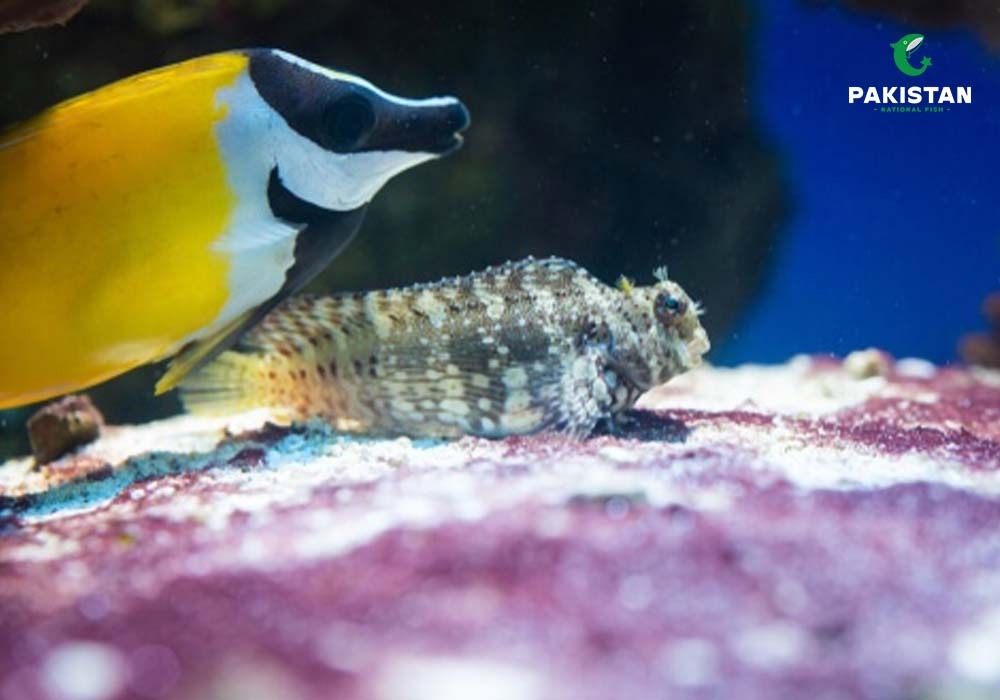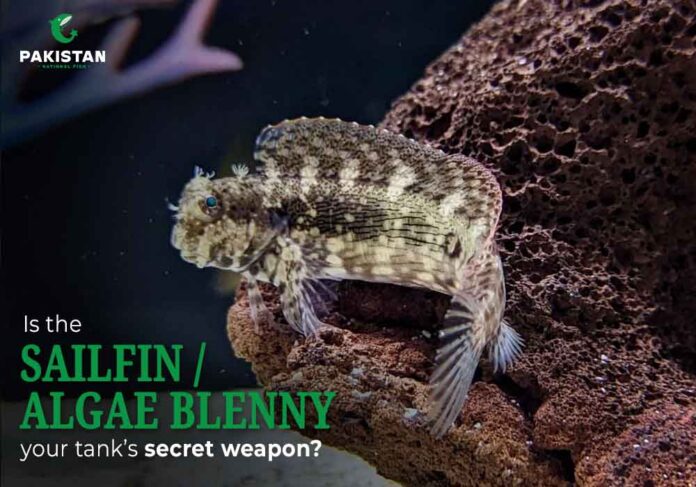Quick Information:
Attribute | Details |
Scientific Name | Salarias ramosus (Starry Blenny, Jewel Algae Blenny) |
Common Names | Starry Algae Blenny, Sailfin Algae Blenny, Jewel Algae Blenny, Lawnmower Blenny |
Care Level | Easy to Moderate |
Temperament | Peaceful |
Color Form | Assorted, Green, Tan, with White to Light Blue Dots |
Diet | Herbivore (Primarily Algae, Supplemented with Spirulina, Vegetable Matter) |
Reef Compatible | Yes |
Water Conditions | Specific Gravity: 1.020-1.025, Temp: 72-78°F, dKH: 8-12, pH: 8.1-8.4 |
Max Size | 5 inches |
Family | Blenniidae |
Minimum Tank Size | 30 gallons |
Why Choose an Algae Blenny for Your Tank?
Picture this: a fish that’s not just a pretty face but also a diligent worker, keeping your aquarium free from pesky algae. That’s the Algae Blenny – Jewel (Salarias ramosus) in a nutshell. Native to the Western Central Pacific, around places like Australia and the Philippines, this fish is a natural algae-muncher, making it a favorite for aquarists who want a low-maintenance, reef-safe companion. Its mottled tan, green, and assorted color palette, sprinkled with pale blue dots, adds a subtle yet striking vibe to your tank. Plus, its dog-like personality—yes, you read that right—makes it a joy to watch as it perches on rocks or hops around like it owns the place.
- Hardy and Resilient: Perfect for beginners due to its easy-to-moderate care level.
- Algae Control: Specializes in eating filamentous algae, keeping your tank pristine.
- Reef-Safe: Won’t harm corals or invertebrates, making it a great fit for reef tanks.
- Compact Size: Grows to a max of 5 inches, fitting well in smaller setups (30 gallons or more).
What Makes the Starry Blenny Care So Simple?
Wondering if starry blenny care is as easy as it sounds? Spoiler alert: it is! The Starry Algae Blenny is a low-fuss fish that thrives in well-established tanks. Its care level is rated easy to moderate, meaning even if you’re new to the hobby, you can handle it with a bit of know-how. The key is maintaining stable water conditions and providing enough algae to keep it happy. Here’s what you need to know:
- Water Parameters: Keep the specific gravity between 1.020-1.025, temperature at 72-78°F, dKH 8-12, and pH 8.1-8.4. Stability is crucial, so regular water testing is a must.
- Acclimation: Use drip acclimation to help your blenny adjust to its new home. Many owners report their blennies hiding for a couple of days before confidently exploring.
- Tank Maturity: A mature tank with plenty of natural algae growth is ideal, as young tanks may not provide enough food, risking starvation.
- Low Maintenance: Once settled, these blennies are self-sufficient algae-eaters, reducing your tank-cleaning workload.
How Does the Sailfin Algae Blenny Keep Your Tank Clean?
The Sailfin Algae Blenny earns its nickname “Lawnmower Blenny” for a reason—it’s like a tiny gardener for your aquarium! This fish loves to graze on filamentous algae, the stringy green stuff that can take over your tank if left unchecked. As it hops from rock to rock, it scrapes off algae, stirring up detritus that your filtration system can then handle. This natural cleaning service not only keeps your tank looking sharp but also supports a healthier environment for your corals and other fish.
- Algae Preference: It targets filamentous algae but may ignore bubble or slime algae, so don’t expect it to tackle every type.
- Detritus Buster: Its feeding habits loosen debris, helping your filter keep the water clear.
- Reef Tank Ally: By controlling algae, it prevents overgrowth that could smother corals or disrupt tank balance.
- Supplemental Feeding: If algae runs low, offer spirulina, nori, or herbivore pellets to keep it satisfied.
What’s the Deal with the Jewel Algae Blenny’s Personality?
The Jewel Algae Blenny isn’t just a fish—it’s a character! Often described as having a “dog-like” personality, this blenny is a curious observer, perching on live rock or even your tank’s thermometer to watch the world go by. Its oversized eyes and quirky movements, like hopping across the substrate or propping itself up on a fin, make it a fan favorite. Owners rave about its ability to change color based on its surroundings, lightening or darkening to blend with the rock or sand. At certain times, its blue spots pop, adding a touch of sparkle.
- Territorial but Peaceful: It’s generally calm but can get feisty with similar-looking fish like other blennies or gobies in smaller tanks.
- Engaging Behavior: Loves to claim a favorite cave or rock as its “home base” and may defend it fiercely.
- Interactive: Some owners report their blennies watching activity outside the tank, almost like they’re studying you!
- Camouflage Artist: Its color-shifting ability adds visual intrigue and helps it blend into its environment.
Fun Fact: One hobbyist named their blenny “Blenny Hill” after the comedian, thanks to its comical antics.
What Tank Setup Suits a Starry Algae Blenny Best?
Setting up the perfect home for your Starry Algae Blenny is key to its happiness. These fish thrive in a 30-gallon or larger tank with plenty of live rock and rockwork for perching, hiding, and grazing. Their natural habitat in shallow reefs and estuaries means they love nooks, crannies, and moderate water flow.
- Tank Size: Minimum 30 gallons, but larger is better for multiple fish or to reduce territorial disputes.
- Live Rock: Essential for algae growth and providing hiding spots. Arrange rocks to create caves and perches.
- Lid Up: Blennies are notorious jumpers, so a secure tank lid is non-negotiable.
- Water Flow: Moderate flow mimics their natural habitat without overwhelming them.
- Reef Setup: Perfect for reef tanks, as they’re safe with corals and invertebrates, though they may nip at small-polyped stony corals or clam mantles.
Who Can Share a Tank with a Jewel Algae Blenny?

Compatible Tank Mates:
- Ocellaris Clownfish (Amphiprion ocellaris)
- Sailfin Tang (Zebrasoma velifer)
- Longnose Hawkfish
- Other peaceful fish with different body shapes
Avoid These:
- Other blennies (unless in a large tank with a mated pair)
- Gobies or dartfish in small setups
- Aggressive fish like Tessalata Eels or Blue Spotted Puffers
What Should You Feed Your Algae Blenny?
The Salarias ramosus is a herbivore with a knack for algae, but it’s not a picky eater. In a mature tank, it’ll happily graze on filamentous algae growing on rocks and glass. However, if algae is scarce, you’ll need to step in with supplemental foods to keep it healthy.
- Primary Diet: Filamentous algae (naturally occurring in the tank).
- Supplemental Foods: Spirulina, nori (seaweed), herbivore pellets, or high-quality flake foods like JBL Maris.
- Live Foods: Copepods and amphipods from a refugium can be a treat.
- Feeding Frequency: Offer algae-based foods 2-3 times daily if natural algae is limited.
Caution: Some blennies may switch to flake or frozen foods and ignore algae, so monitor their diet to ensure nutritional balance.
Curious About Common Questions? Let’s Dive In!
It grows to about 4-5 inches in captivity, making it a great fit for smaller tanks (30 gallons and up). Its compact size doesn’t compromise its big personality.
Nope! While both are small, bottom-dwelling fish, gobies (family Gobiidae) and blennies (family Blenniidae) are distinct. Blennies, like the Starry Blenny, have a single, long dorsal fin and often eat algae, while gobies may have different diets and body shapes. They can look similar, so your blenny might get territorial with gobies in tight spaces.
Not at all! Most blennies, including the Salarias ramosus, are non-venomous. Some blenny species, like fang blennies, have venomous bites, but the Algae Blenny is harmless and safe for community tanks.
With proper care, a Starry Algae Blenny can live up to 5 years in captivity. A stable environment, good diet, and stress-free tank mates are key to a long, happy life.
To Be Continued…
The Algae Blenny – Jewel is more than just a fish—it’s a tank-cleaning, personality-packed addition that brings life to your aquarium. From its algae-munching prowess to its quirky, watchful nature, this fish is a must-have for anyone looking to combine function with fun.
Stay tuned for our next blog, where we’ll explore another reef-safe superstar to elevate your tank game! Got a fish you’re curious about?
Drop a comment below, and we’ll cover it next!


